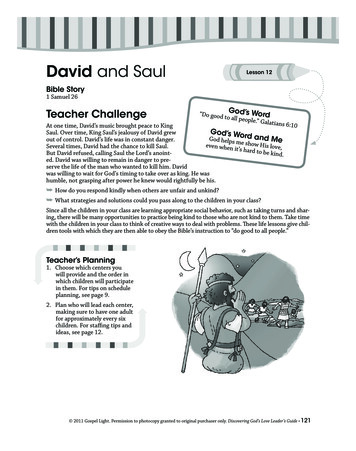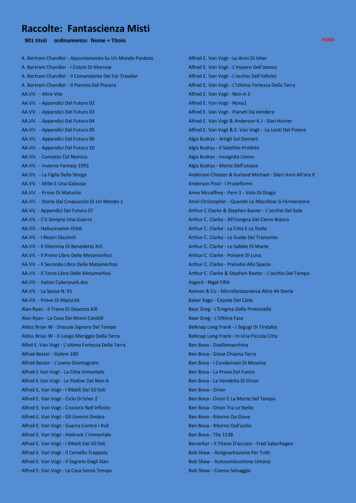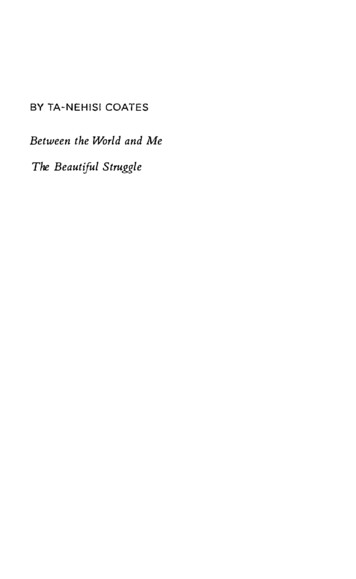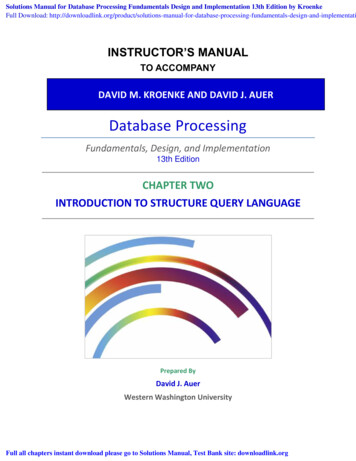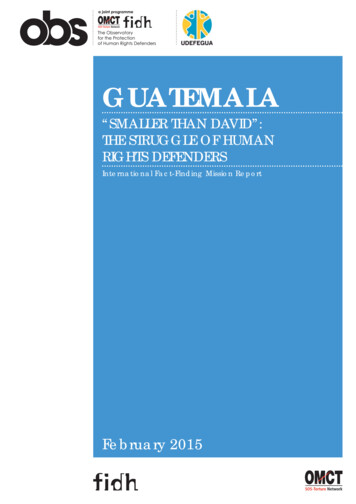
Transcription
GUATEMALA“SMALLER THAN DAVID”:THE STRUGGLE OF HUMANRIGHTS DEFENDERSInternational Fact-Finding Mission ReportFebruary 2015
Source: Perry-Castañeda Library Map Collection - http://www.lib.utexas.edu/maps/guatemala.htmlOMCT and FIDH would like to thank the Republic and Canton of Geneva, Dutch Ministryof Foreign Affairs, Finnish Ministry of Foreign Affairs, Fondation de France, Fondation“Un Monde par tous”, French Ministry of Foreign Affairs, International Organisation of LaFrancophonie (OIF), Mairie de Paris, Norwegian Ministry of Foreign Affairs, Open SocietyFoundation, Sigrid Rausing Trust (SRT) and Swedish International Development CooperationAgency (SIDA) for making the publication of this report possible. Its content is the soleresponsibility of OMCT and FIDH and should in no way be interpreted as reflecting theview(s) of the supporting institutions.The ObservatoryGUATEMALA - “Smaller than David”: The struggle of human rights defenders
TABLE OF CONTENTSI.II.INTRODUCTION2HISTORIC, ECONOMIC AND POLITICAL CONTEXT3334452.1 Civil war and peace treaties2.2 Security, organised crime and violence2.3 The fight against impunity2.4 Economic development and poverty2.5 Current political climateIII. LEGAL AND INSTITUTIONAL FRAMEWORK UNDERWHICH DEFENDERS PURSUE THEIR ACTIVITIES3.1 National framework3.2 International framework3.3 Regional framework3.4 Overview of human rights in the country3.5 The right to defend human rights in Guatemala:legal and institutional framework3.5.1 Human rights legal frameworks essentialto the work of human rights defenders3.5.2 Institutional mechanisms for protecting human rights defenders3.6 Conclusions on the legal and institutional frameworkunder which defenders pursue their activitiesIV. ANALYSIS OF THE SITUATION OF HUMAN RIGHTS DEFENDERS4.1 General approach4.2 Criminalisation and attacks against activists defending land rightsand the rights of indigenous peoples4.3 The criminalisation of other human rights defenders4.3.1 Defamation of defenders of truth and justice4.3.2 Women’s human rights defendersV.COMMUNITIES TAKING A STAND AGAINST THE NEGATIVEIMPACTS OF MINING AND HYDROELECTRIC PROJECTS5.1 Santa Cruz Barillas5.2 La Puya5.3 San Rafael Las Flores (Santa Rosa) and Mataquescuintla (Jalapa)778991010182021212325252628283535VI. CONCLUSION39VII. RECOMMENDATIONS41ANNEX 1: OBJECTIVES45ANNEX 2: METHODOLOGY47Directors of publication: Gerald Staberock, Karim Lahidji, Claudia Virginia Samayoa.Drafting: Miguel Martín Zumalacárregui, Angela Méndez Izquierdo, Claudia Virginia Samayoa.Edition and coordination: Miguel Martín Zumalacárregui, Alexandra Poméon O’Neill, Claudia Virginia Samayoa.Translation into English: Danielle Louise PerkinsDistribution: The full text of this report is published in Spanish and English.Copyright: The World Organisation against Torture (OMCT) and the International Federation for Human Rights (FIDH)authorise the free reproduction of extracts of this text on condition that the source is credited and that a copy of the publicationcontaining the text is sent to their respective International Secretariats.Graphic design: MOSTRA SARLPrinted by OMCTOMCT ISBN 978-2-88894-061-6The ObservatoryGUATEMALA - “Smaller than David”: The struggle of human rights defenders1
I. INTRODUCTIONGiven their concerns about the situation of human rights defenders in Guatemala, in particular about the smear campaigns criminalizing and defamation of human rights defenders andorganisations in the country, the Observatory for the Protection of Human Rights Defenders,together with the World Organisation against Torture (OMCT) and the International Federation for Human Rights (FIDH), decided to undertake an international fact-finding mission.The purpose of the mission, which took place from November 7 until November 15, 2013,was to verify and evaluate the situation of human rights defenders in Guatemala in situ.A documentary filmmaker accompanied the mission’s rapporteurs and was responsible forfilming their activities and producing a follow-up documentary of the mission upon its completion. The documentary entitled “Más pequeños que David” (English translation: ‘Smallerthan David’) can be found on the official websites and social networks of the OMCT and theFIDH, the two organisations that form the Observatory.Human rights defenders in Guatemala undertake their activities in extremely vulnerableconditions. In recent years the issues of most noticeable concern are the smear campaignsbeing launched against them and the criminalisation and persecution of their activities.The mission focused its attention on the smear campaigns waged against land rights defenders and on the criminalisation of their activities. The Observatory defines land rightsdefenders as those individuals or organisations belonging to civil society that seek to protectand promote land-related human rights, in particular by peacefully protesting the adverseimpacts of development projects.The reason the mission chose to focus its attention on the situation faced by land rightsdefenders was due to the gravity of the reports the Observatory had received regardingviolence against defenders who were speaking out against companies involved in naturalresource extraction1. In this regards, land rights defenders are the second most vulnerablesocial group in Guatemala.The most common types of attacks suffered by this group include: threats, attempts againsttheir lives and physical attacks, and also criminal persecution and defamation. This socialconflict that relates to mining and extraction projects, hydroelectric projects or monocultureplantation projects is widespread across the country, and the mishandling of events by government authorities has led to an unsettling climate of hostility and violence.However, it is important to mention that although the primary objective behind the missionwas to assess the situation of land rights defenders the mission’s rapporteurs also investigated the situation of women’s human rights defenders and the situation of defenders fightingagainst impunity.Although the high incidences of common violence in the country also affect human rightsdefenders, the dramatic increase in documented aggressions in 2013 is primarily the result ofchanges in transitional justice that took place that same year; of the 657 documented aggressions, 326 were committed against defenders working in the field of truth and justice2. Weare referring to the genocide trial and the media smear campaign that targeted defenders,both of which shall be dealt with in more detail further on.The OMCT and the FIDH would like to offer their thanks to the representatives of all theinstitutions, members of the diplomatic corps, human rights defenders, representatives fromcivil society, and victims that lent their support to the mission for their assistance and for theinformation provided. We would also like to add that the mission’s work would have beenimpossible had it not been for the support and efforts of the Unit for Protecting Human RightsDefenders in Guatemala (UDEFEGUA).122See Observatory for the Protection of Human Rights Defenders, Annual Report 2011, p. 226.See UDEFEGUA, El silencio es historia, Estado de Situación 2013, 2014, p. 1. Available at: acompanante.The ObservatoryGUATEMALA - “Smaller than David”: The struggle of human rights defenders
II. HISTORIC, ECONOMIC AND POLITICALCONTEXT2.1 Civil war and peace treatiesThe civil war in Guatemala ran for 30 years, from 1962 until 1996, the year in which theFirm and Lasting Peace Treaty was signed by the Government and the Guatemalan National Revolutionary Unity (URNG). In July 1997 the work of the Commission for HistoricalClarification (CEH) began. This body is a truth and reconciliation commission sponsored bythe United Nations and it is responsible for investigating violations that take place duringinternal armed conflicts.In its report, the CEH estimated that there had been more than 160,000 executions and40,000 forced disappearances and thus concluded that 93% of registered human rights violations were attributable to the State and to paramilitary groups that were acting with consent or financial backing from the State3. The massacres that took place followed patterns ofdiscrimination in which the majority of victims were indigenous peoples and large numbersof women became the victims of sexual assaults4. The commission also concluded that in theyears 1980 – 1983, genocide was perpetrated against the Maya Ixil5.Decades of armed conflict and prolonged periods of military governments gave rise to aState and society that was heavily militarized. In addition, the impunity of crimes committedduring that era led to a lack of public trust in the government and the legal system6, a factthat still holds true today.The Peace Treaty provided the foundation for radical reforms in each of the country’s sectors,including the fundamental issue of agrarian reforms. However, these reforms were neverimplemented due to a lack of support from Congress7.2.2 Security, organised crime and violenceExtreme levels of violence have been documented in the country and the murder rate standsas one of the highest in the world8. In 2011 the figure for violent deaths stood at 5,681 individuals9, dropping to 5,155 in 201210. In 2013, this decline was reversed and the figure forrecorded violent deaths stood at 6,072 individuals.Thus, statistics from the Guatemalan National Institute of Forensic Science (INACIF) and theNational Civil Police (PNC) indicate that the number of homicides rose by 4.3% to 6.5%, andthat the homicide rate for women rose between 17% and 26%11. The nature of violence justdescribed together with the impunity witnessed in the country has led to a widespread senseof insecurity that has permeated society.3See Comisión para el Esclarecimiento Histórico (Commission for Historical Clarification), Guatemala, Memoria del Silencio,1999.See Guatemala: Asfixiada entre el Crimen y la Impunidad, Informe sobre América Latina No. 33, 2010, p. 3.5See Comisión para el Esclarecimiento Histórico (Commission for Historical Clarification), Guatemala, Memoria del Silencio,1999, para. 3357.6See International Crisis Group, Guatemala: Asfixiada entre el Crimen y la Impunidad, Informe sobre América Latina No. 33,2010, p. 4.7Idem, p. 5.8See UNDP, Regional Human Development Report 2013-14. Citizen security with a human face: evidence and proposals for LatinAmerica. Available at: http://hdr.undp.org/sites/default/files/citizen security with a human face -executivesummary.pdf.9See Office of Human Rights of the Archbishop of Guatemala, ODHAG, Violence in Guatemala. A reflection on the rise indelinquency and psychological trauma, 2012, p. 8.10See Mendoza, Carlos A. (CABI) and Méndez Arriaza, Claudia (El Periódico), Seven myths about homicidal violence inGuatemala. Research published in El Periódico and available at: /Portada.11See OHCHR, Report on activities of the Guatemalan Office for 2013, UN Document A/HRC/25/19/Add.1, p. 10, para. 42.4The ObservatoryGUATEMALA - “Smaller than David”: The struggle of human rights defenders3
Furthermore, the government’s inability and/or lack of interest in tackling the issue of impunity combined with corruption in state institutions has provided fertile ground for organisedcrime to flourish12 and resulted in drug-trafficking rings seizing control in some areas of thecountry and wielding influence at higher levels of certain state institutions i.e. the police, thelaw courts, the Public Ministry and the Ministry of the Interior13.2.3 The fight against impunityFrom 2009 to 2012, figures for impunity show a drop from 95% to 72% in crimes involvingthreats against life14. What these figures show is how structural reforms and changes in thestrategic focus of the judicial administration produced tangible results. However, it is important to point out that levels of impunity continue to remain high in cases involving defenders,as shall be detailed further on.With regards to transitional justice, in March 2013 a trial was held involving the retired military personnel and former dictator Efraín Ríos Montt, and José Mauricio Rodríguez Sánchez.They were tried for the crime of genocide against the Maya Ixil indigenous people that tookplace in the 1980s. The trial was closely followed by the national and international mediabecause of an interest in the political and legal battles being played out and the numerousprocedural delay tactics that arose during its course, the most important of which included:an attempted appeal for legal protection by means of an amnesty (intento de amparo) included in the National Reconciliation Act, which does not apply in the case of crimes of genocide;the attempted annulment of the trial in April 2013 following an alleged court order from theConstitutional and Supreme Courts of Guatemala; the annulment of practically the entiretrial decreed by the Constitutional Court in May 2013 that also included the 80-year prisonsentence of Mr Ríos Montt.When faced such a disheartening scene, it is important to remember that in recent yearsGuatemala has taken unprecedented steps in the fight against the impunity of crimes committed during the armed conflicts. The aforementioned case of the former dictator Ríos Monttwas the last of many from that era of internal armed conflict to be put on trial and givensentences since 2009.2.4 Economic development and povertyGuatemala occupies position 133 in the United Nations Human Development Index (UN).However, after Haiti, it occupies second place on the list of countries with the lowest indexof the Latin American continent15. The agricultural sector is at the forefront of the nationaleconomy and it is a sector that employs nearly half of the entire labour force16.Although figures many vary depending on the source being consulted, it is possible to confirm that indigenous peoples make up at least seventy percent of the Guatemalan populationand that they belong to the following three tribes: the Maya, the Garifuna and the Xinca.Looking at the rural population, 70.5% live in poverty or extreme poverty17. Taking into account the fact that the majority of the indigenous population lives in rural areas, it is evidentthat there is a pattern of discrimination surrounding the issue of poverty in Guatemala. Oneof the effects of rural poverty is the persistence of chronic malnutrition, which has been recognised by the government as a causal factor in the internal armed conflicts18.12Guatemala occupies position 123 in the Transparency International Perception Index for 2013.See International Crisis Group, Guatemala: Asfixiada entre el Crimen y la Impunidad, Informe sobre América Latina No. 33,2010, p. 19.14Information obtained from a comparison of data from the National Civil Police performed by the UDEFEGUA.15See UNPD, Human Development Report 2013. Available at: 4/hdr2013 encomplete.pdf.16See International Crisis Group, Guatemala: Asfixiada entre el Crimen y la Impunidad, Informe sobre América Latina No. 33,2010, p. 2.17See United Nations, Core document forming part of reports of State parties Guatemala, Document HRI/CORE/GTM/2012,para. 25.18See CIFCA, OMCT, APRODEV, La Via Campesina (International Peasant Movement), FIAN, CIDSE, FIDH, The right to foodin Guatemala. Final report of the international fact-finding mission, 2010, p. 9. Available at: and-publications/guatemala/2010/03/d20585/.134The ObservatoryGUATEMALA - “Smaller than David”: The struggle of human rights defenders
Since the 1990s a series of legal reforms have been implemented in relation to the naturalresource extraction industry. Using these reforms, changes were also made to mining legislation in an attempt to create attractive opportunities for foreign investors19.Therefore the Small-Scale Mining Act and the reforms made to the Mining Act cut back onred tape, thus making it much easier for mining permits to be granted. They also eliminatedthe need for express written permission from the landowner for a mining project20.This fact, together with a combination of other factors, has contributed to the increasingamount to social conflict surrounding land tenure, particularly in relation to: legislation, policies and public practices that favour foreign companies in order to promote industry andgenerate more tax dollars, which in fact generate little or no benefits for the country itself;the existence of poor supervisory mechanisms to monitor the activities of transnational enterprises; vague and inconsistent environmental policies21; the insufficient investment of resources in the bodies responsible for ensuring said legislation is complied with; and finally,the systematic violation of the right of the population that is being affected by the mining andhydroelectric projects to prior, free and informed consultation.The landmark case involving the company Montana Exploradora de Guatemala S.A., a subsidiary of the Canadian enterprise Goldcorp, highlights the general problem surroundingsuch projects. The company was granted exemption from paying taxes on its mining activities at the Marlin mine, thus illustrating how the riches generated from such projects tend tobe transferred abroad, whilst the burden of environmental, cultural, social, and health costsmust be borne internally22.Furthermore, in Guatemala is it possible to observe a structural divide in terms of access toeconomic, social or cultural rights. We shall discuss this in more detail in the section dealingwith the impact of human rights on the legal and institutional framework23.2.5 Current political climateOn January 14, 2012 President Otto Pérez Molina of the political party Partido Patriota wassworn into office, anchored ideologically in the liberal right. In his inaugural address he declared that his government would work on three important national pacts that reflected thenation’s priorities: 1) the Security, Justice and Peace Pact, 2) the Fiscal and CompetitivenessPact, and 3) the Zero Hunger Pact.That same year, Guatemala began work in its capacity as a non-permanent member of theSecurity Council and was examined for the second time under the framework of the universal periodic review in October that year (the previous exam took place in May 2008 and thenext shall take place in 2017). It also presented a proposal to the United Nations GeneralAssembly and the Organization of American States General Assembly with the aim of discussing new approaches to tackling drug trafficking. The legislation that was passed duringthis initial phase included: the 2012 budget; fiscal reforms; the creation of the new Ministryof Social Development (MINDES); the ratification of the Rome Statute; and the creation of theEconomic and Social Council of Guatemala.During his first year in office, Pérez’s government launched a number of large-scale proposals including the proposals to decriminalize drugs, reform the Constitution of the Republic,reform the educational system, pursue a comprehensive fiscal reform, approve the RuralDevelopment Act, create a body through which it were possible to centralise the drive fortransparency, and action the ‘Security and Combating Organised Crime’ plan.19See Simona -v- Yagenova, Claudia Donis, Patricia Castillo, The extraction industry in Guatemala: Public policies, humanrights, and popular resistance movements from 2003-2011, Social Sciences Editorial, Guatemala, 2012, p. 23.20See Small-scale Mining Act, Decree 55-1990; Mining Act, Decree 41-1993 and Decree 48-1997.21See Simona -v- Yagenova, Claudia Donis, Patricia Castillo, The extraction industry in Guatemala: Public policies, humanrights, and popular resistance movements from 2003-2011, Social Sciences Editorial, Guatemala, 2012, p. 29-30.22Idem, p. 32.23See Section 3.4 of this report: Overview of human rights in the country.The ObservatoryGUATEMALA - “Smaller than David”: The struggle of human rights defenders5
However, this ambitious agenda has come to little in a practical sense, except for the fiscalreform - a single component of the Fiscal Pact for change, the left remaining undelivered and a minor improvement in the figures for crime and violence in 2012 before reversals inthese figures were seen in 2013, as mentioned previously24.The constitutional reforms laid out by the government were aimed at promoting structuralchange in the judicial system as well as in the use of public resources, the structure andfunctions of Congress, and the recognition of the rights of the indigenous peoples. In theend it was the government that requested to Congress that the talks be suspended. It alsoannounced that existing human rights institutions would be restructured into a single entity:Secretariat for Human Rights and Peace.Certain political setbacks, such as the withdrawal of proposals for constitutional reform andthe failure to pass the Rural Development Act that sought to tackle the problematic issue ofland use, together with other serious events i.e. the massacre of community members of thecommittee group 48 cantones de Totonicapán at the hands of the military at the site calledCumbre de Alaska in 2012, the massacre at San José Macahuil in San Pedro Aymapuc inSeptember 2013 in which 11 died and 15 were injured, supposedly at the hands of organisedcrime25, and the pursuit of mining and hydroelectric projects in direct violation of the right toprior consultation on the part of the affected communities has all led to a significant increasein the amount of social unrest and conflict.Lastly, it is important to mention how measures taken by the current government had led tothe remilitarisation of the country. In 2012, military presence in the country increased with theintroduction of two new brigades and the announcement that two further measures would alsobe introduced, 1) military checkpoints in the city, and 2) police and army patrols26. Despite allthe promises that the National Civil Police would be reinforced the police force was only increased by 4.7% whilst the army increased by 11.8%27. In 2013, the same trend continued. As aconsequence there was an increase in the combined use of police and military forces that saw1500 military personnel being deployed in Escuintla, Huehuetenango and Zacapa28.The risks involved in using the military to prove public safety became all to clear when six indigenous people were killed and a further 20 injured by military personnel during the “Cumbrede Alaska” protests that were organised by the traditional community leaders of Totonicapán29.The other consequences arising from this remilitarisation include former military personnelholding positions of power in the seat of government30 and the approval of a budget in 2013that was weighed in favour of the Ministry of National Defence and the Ministry of the Interior, while the amount allocated to the judicial system and the Public Ministry31 was reduced.And finally, it is vital to mention that the Government and former governments also resortedto declaring a state of siege in the Municipality of Santa Cruz Barillas, Huehuetenango inMay 2012, and then in Santa Rosa and Jalapa the following year in May 2013. In both cases,the trigger for these actions lay in the conflicts associated with natural resource extractioninvestment projects32.24See Section 2.2 of this report: Security, organised crime and violence.See Prensa Libre, Matanza en San José Nacahuil deja 11 muertos y 15 heridos (Massacre at San José Nacahuil leaves 11dead and 15 injured), September 8, 2013. Available in Spanish at: reSan-Pedro-Ayampuc-muertos 0 989301109.html26See United Nations Human Rights Council, Periodic Report of the UN High Commissioner of Human Rights on activities ofthe Guatemalan Office for 2012, UN Document A/HRC/22/17/Add.1, January 7, 2013, Guatemala p. 8.27Idem.28See OHCHR, Report on activities of the Guatemalan Office for 2013, UN Document A/HRC/25/19/Add.1, p. 10.29See United Nations Commission on Human Rights. Periodic Report of the UN High Commissioner of Human Rights on activities of the Guatemalan Office for 2012, UN Document A/HRC/22/17/Add.1, January 7, 2013, Guatemala, p. 5.30For example, regarding security: (.) “General Ricardo Bustamante, right hand to the President and former colleague in D-2,shall lead the National Security Council; Colonel Walter Zepeda Chavarría, shall act as Secretary of Presidential Administrative Affairs and Security (SAAS); Mauricio López Bonilla, retired Lieutenant Colonel, in the Ministry of the Interior; andUlises Anzueto Girón, in the Ministry of Defence”; See Plaza Publica, Baires Quezada, Rodrigo, Presupuesto: más represiónque investigación y justicia (English translation - The Budget: more repression than investigations or justice). Available inSpanish at: -mas-represion-que-investigacion-y-justicia.31See Plaza Publica, Baires Quezada, Rodrigo, Presupuesto: más represión que investigación y justicia. (English translation- The Budget: more repression than investigations or justice). Available in Spanish at: -mas-represion-que-investigacion-y-justicia.256The ObservatoryGUATEMALA - “Smaller than David”: The struggle of human rights defenders
III. LEGAL AND INSTITUTIONAL FRAMEWORKUNDER WHICH DEFENDERS PURSUE THEIRACTIVITIESFollowing the recommendations from the UN’s Universal Periodic Review (UPR) in 2008,Guatemala adopted certain regulatory reforms with ramifications at both a national and international level. In the second review that took place in 2012, the efforts that were madefollowing the 2008 review were recognised, although further recommendations were made,especially in relation to: the ratification of the Optional Protocol to the International Covenant on Economic, Social and Cultural Rights and the Second Optional Protocol to the International Covenant on Civil and Political Rights; the abolition of the death penalty; the needto adopt legislation that would protect the rights of indigenous peoples (in particular withregards the right to prior consultation), journalists and other human rights defenders, or prevent violence against women, child labour or better defend the rights of disabled workers.3.1 National frameworkAt the national level, the following legislative instruments that address human rights haverecently been adopted: In 2008, the Femicide and other forms of Violence against Women Act was established,representing a major legal advancement in the field of protection of women’s rights. A yearlater, the Sexual Violence, Exploitation and Human Trafficking Act was passed, allowingseveral offenses to be reformed under the Guatemalan Criminal Code, i.e. rape and humantrafficking, as well as the inclusion of new criminal offenses, i.e. the offense of employingminors in work activities harmful to their integrity and dignity. Furthermore, offenses suchas abduction and defilement, whose descriptive elements belong to the reformed offenseof rape, were abrogated. The aim of the law is to prevent, repress, punish and eradicatesexual violence, exploitation and human trafficking, care for and protect the victims andcompensate them for the damages caused. The Alba-Keneth Alert System Act passed on August 12, 2010 and reformed by DecreeNumber 5-2014 of the Congress of the Republic. The law aims to locate and immediatelyprotect missing or abducted children. The Housing Act was enacted with the purpose of regulating and promoting State actionsto coherently develop aspects related to housing, its services and social equipment in order to allow Guatemalan families access to decent, adequate and healthy housing withfurnishings and services. In the field of strengthening national capacity for criminal prosecution, Decree Number17-2009, Strengthening Criminal Prosecution Act, was passed including reforms of theCriminal Code, Code of Criminal Procedure, the Organised Crime Act and the ExtraditionProcedures Act. Regarding indigenous peoples, the following bills were presented to the Congress of theRepublic of Guatemala: General Act relating to Indigenous Peoples, Consultation of Indigenous Peoples Act, Indigenous Costume Act and Indigenous Jurisdiction Act. On April 3, 2013, the government issued Governmental Agreement 145-2013 declaring thenational urgency and public need to construct the works included in the Transport Expansion Plan (PET) and the Rural Electrification Plan (PER). Institutional Strengthening, Transparency and Quality of Public Spending Act, October2013, which establishes reforms intended to reinforce controls in the Superintendence ofTax Administration (SAT), Comptroller of Public Accounts, National Budget Act, PublicProcurement and Probity and Responsibility of Civil Servants Act.32In the case of Santa Cruz Barillas, and according to OHCHR, “the decree by which a state of siege was decreed lacked sufficient justification and an analysis of need, exceptionality and proportionality”. See United Nations Commission on HumanRights, Periodic Report of the UN High Commissioner of Human Rights on the activities of the Guatemalan Office for 2012,UN Document A/HRC/22/17/Add.1, January 7, 2013, Guatemala, p. 8. See also Office of the United Nations High Commissioner, Periodic Report of the UN High Commissioner of Human Rights on activities of the Guatemalan Office for 2013,January 13, 2014, p. 15.The ObservatoryGUATEMALA - “Smaller than David”: The struggle of human rights defenders7
At an institutional level, the Secretariat against Sexual Violence, Exploitation and HumanTrafficking was established in 2009. Following this, in 2012, the Ministry of Social Development (MINDES) was also established, as was the Presid
The Observatory GUATEMALA - "Smaller than David": The struggle of human rights defenders 1 Directors of publication: Gerald Staberock, Karim Lahidji, Claudia Virginia Samayoa. Drafting: Miguel Martín Zumalacárregui, Angela Méndez Izquierdo, Claudia Virginia Samayoa. Edition and coordination: Miguel Martín Zumalacárregui, Alexandra Poméon O'Neill, Claudia Virginia Samayoa.


![No, David! (David Books [Shannon]) E Book](/img/65/no-20david-20david-20books-20shannon-20e-20book.jpg)

